All about action and its cultivation
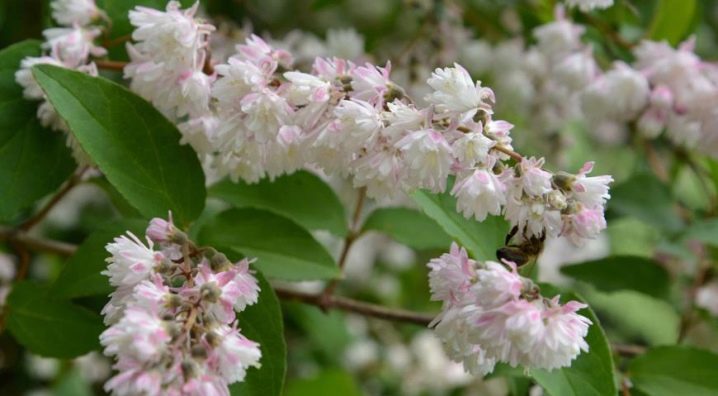
Deytsia is a beautiful ornamental shrub native to Asia. The plant is very beautiful and easy to care for. Therefore, it is happily grown in many areas.
general description
Exotic action looks like honeysuckle. The plant is a perennial. It belongs to the hydrangea family. His "relatives" are now widespread throughout the world.

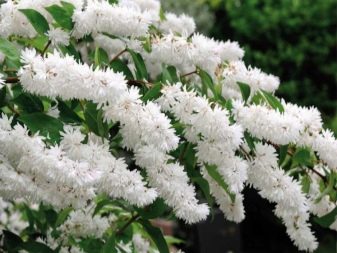
The crown of a large shrub consists of long shoots. They can be either smooth or pubescent. Their bark becomes coarse over time. The height of the bush varies between 1-3 meters. The action is growing rather quickly. It usually blooms for 3-5 years of life.
The leaves of the plant are elongated in length. The flowers are simple, collected in large inflorescences. Their color can be either white or light pink or red. The flowering period lasts several months. After its completion, the flower falls off, and in its place a small fruit with seeds is formed. They are used in nature for plant propagation.
The shrub lives for about 20-30 years. During all this time, it remains a real decoration of the site.
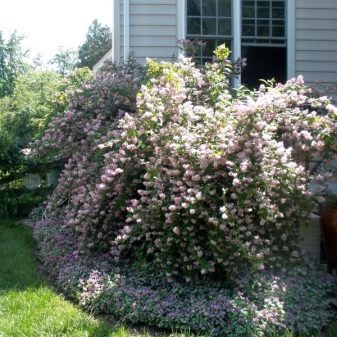
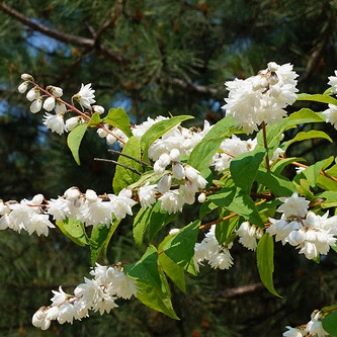
Popular species and varieties
Many breeders show interest in action. Therefore, now there are many different species and varieties of this exotic plant. The most popular are the following ones.
- Small-colored. This plant is also often called Amur deytion. It is widespread in Russia and in many Asian countries. Deciduous shrub grows up to two meters in height. His crown is spreading. The branches of the plant are covered with brown bark, which turns gray over time. The foliage of such a shrub is long. It has the shape of an ellipse. The size of the leaves is small. This type of action does not bloom for long.
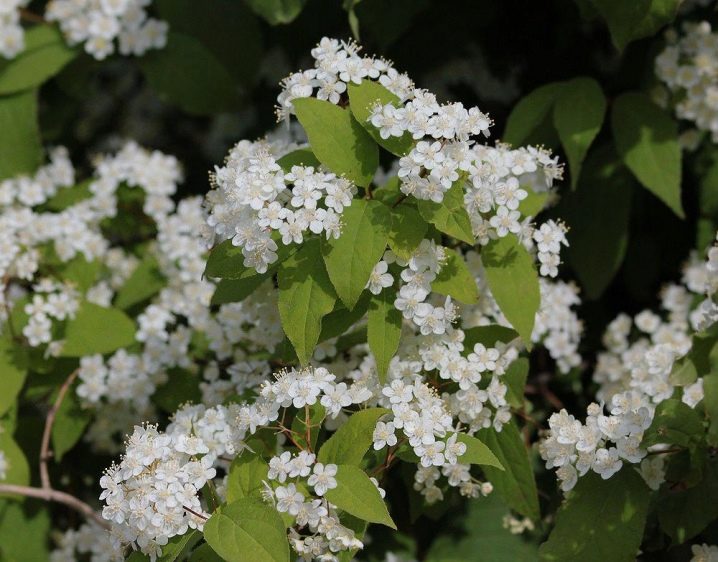
- Graceful. This type of action is small in size. It grows in height up to 50-80 centimeters. The foliage of the plant is elongated, with pointed edges. From the bottom, the leaves are covered with short hairs. The flowers of this type of action are white.
They appear on the bush in mid-July. Flowering lasts a little over a month.
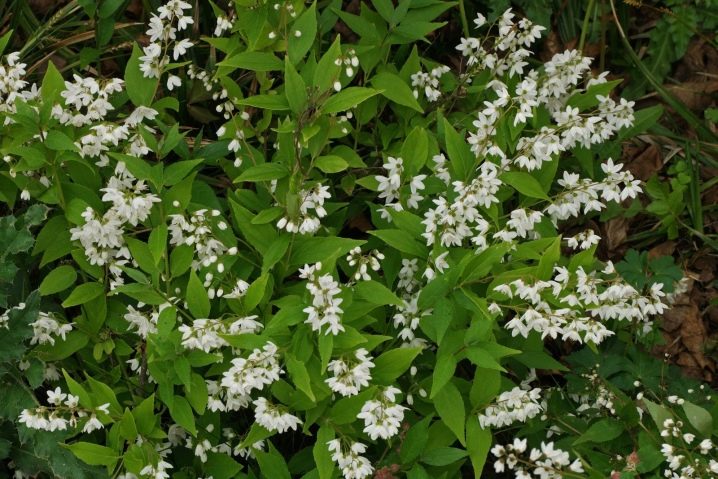
- Rough. This shrub is also known as star-shaped action. It grows naturally in Asian countries. The shrub can grow up to 2.5 m. It always looks very beautiful and graceful. The plant blooms later than others. Flowering lasts about three weeks. The dainty plant buds can be pink or white. It is recommended to plant the bush in open sunny areas.
Especially if the plant is grown in a cold region.
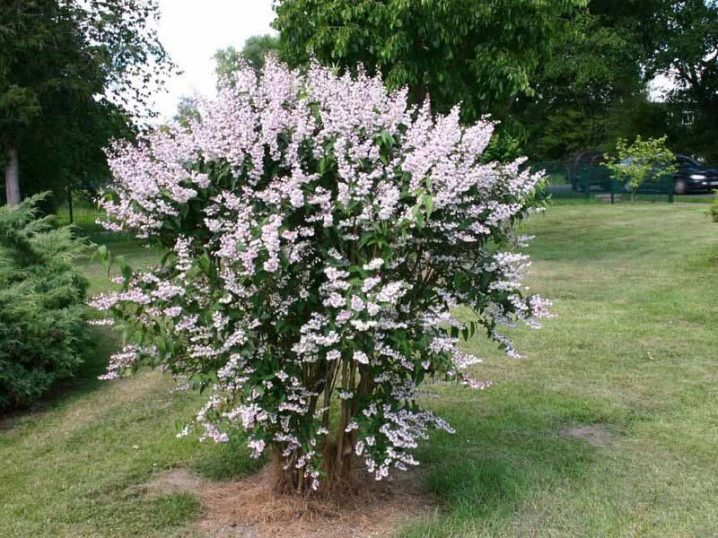
- Lush. This hybrid plant is popular with many gardeners. It also grows in height up to 2.5 m. Its foliage is elongated in length, and the flowers are white. Many people call this plant one of the most beautiful.

- Long-leaved. The height of this shrub varies within two meters. Its shoots are pubescent. The foliage is dark green in color. The buds of the plant are light purple.
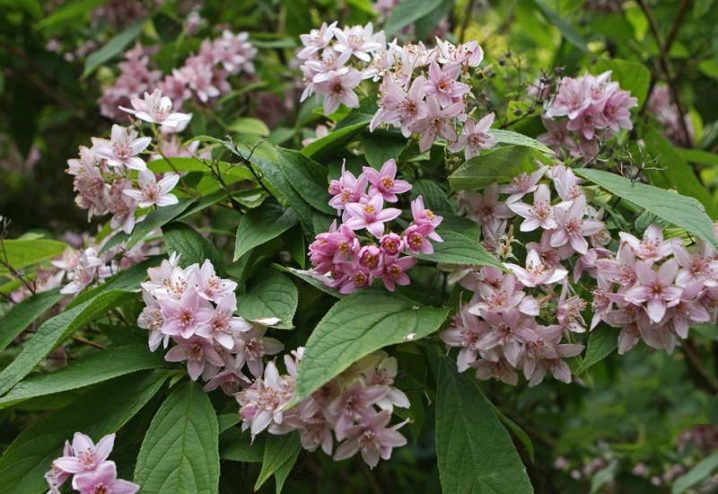
- Lemoine. This is another hybrid plant. It grows up to two meters in height. Lovers of this plant are pleased with its frost resistance. If you care for the shrub correctly, it will always be healthy and beautiful.
One of the most popular varieties of such a plant is Mont Rose. It can be recognized by its bright pink flowers with yellow anthers.
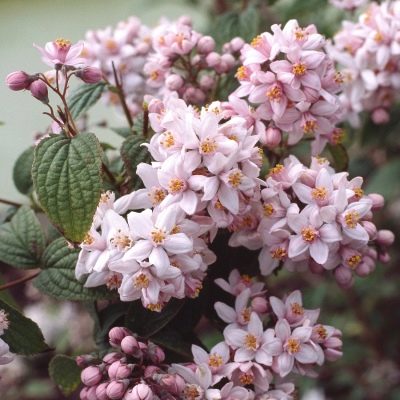
- Strawberry Fields. It is a short hybrid plant with dark green rough leaves. His flowers are large, pink in color. Their central part is bright red. This type of action blooms in the middle of summer. The plant does not differ in good winter hardiness. Therefore, for the winter it must be reliably covered.
In the Urals and in other cold regions, it is not worth planting a culture.
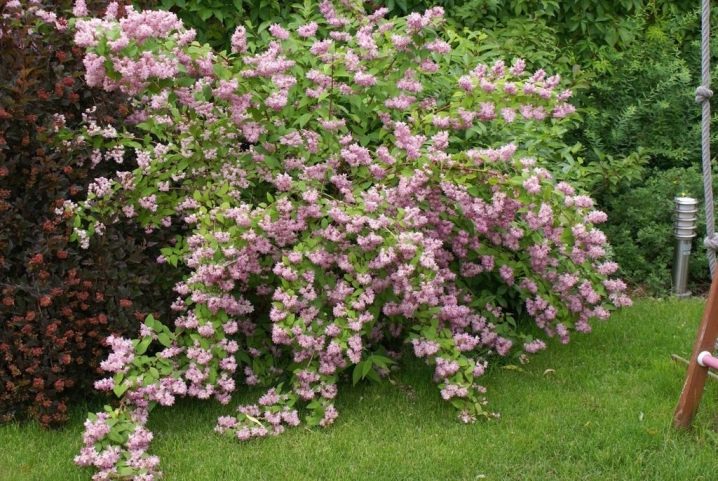
- Smooth. This plant is very rare. By its appearance, this type of action resembles the Amur one. Differs in a later onset of flowering. This type of action blooms only in the 8th year after planting.

- Gorodchaty. This action begins to bloom in May. Her buds are white and rather large. During flowering, the shrub looks spectacular and immediately attracts attention.
Seedlings of all plant varieties can be easily found commercially. The same goes for seeds.
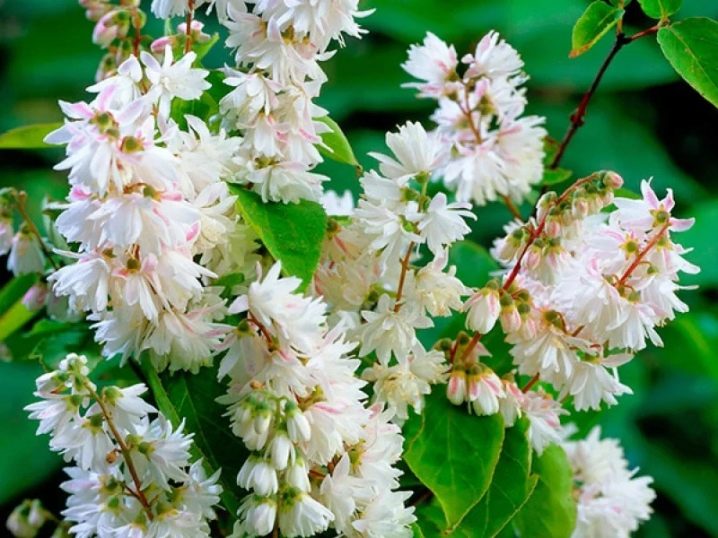
Landing
Before planting the action in open ground, you need to choose a suitable site for it. The plant loves nutritious and well-drained soil. The selected area must be well protected from cold winds. Direct sunlight should only hit the foliage before noon.
It is recommended to plant the action in late spring or early summer. In a few warm months, she will have time to settle down on a new site. Before planting the action, the selected seedling must be inspected. It must be healthy, free from mold and mechanical damage. You need to buy seedlings just before planting.
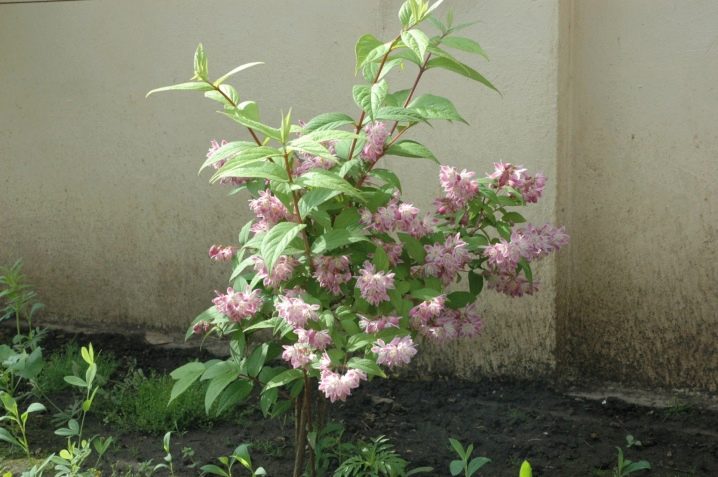
The process of disembarking action on the site consists of the following steps.
- First you need to carefully examine the plant. The broken parts of the rhizome must be cut off. If they are dry, the root must be dipped for several hours in a container with a clay mash, to which a solution of potassium permanganate was added.
- You need to dig a hole in the selected area. Its depth should be within 40 centimeters. The bottom of the hole needs to be filled with broken bricks or stones. Then the earth must be mixed with humus. This mixture is poured into a pit.
- A seedling is placed on the prepared "pillow". Sprinkle it on top with the rest of the soil.
- After planting, the soil is tamped well. Next, the site is watered with warm, settled water.
- To stimulate growth, the crown of action is shortened after planting.
In the open field, plants take root very quickly. It should be remembered that the action does not tolerate a transplant. Therefore, the place for its landing should be chosen carefully.

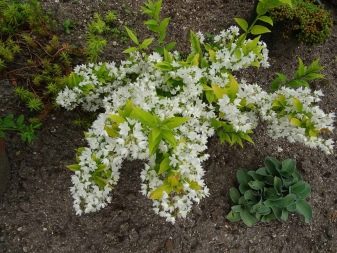
Care
For normal development and regular flowering action, you need to provide proper care.
Watering and feeding
All gardeners who want to grow action in their area should remember that this plant does not react well to waterlogging. Therefore, the shrubs should be watered sparingly. No more than 10 liters of water is poured under one bush. Watering is carried out 1-2 times a month. If the weather is dry, the land is irrigated more often. Water for irrigation is used settled. It is best to keep it warm.
To keep moisture in the soil longer, the soil next to the trunk is carefully mulched. For this, you can use dry foliage, peat, or even sawdust. They are laid in a thick layer. It is important to ensure that the mulch does not come into contact with the tree trunk.
It is best to fertilize the action with organic matter. During the flowering period, the shrub is fed monthly. After applying top dressing, the shrub must be watered. Plants can be fed with complex fertilizers twice a season. After fertilization, the soil is also moistened with warm water.


Pruning
In the process of growing a plant, timely pruning of the shrub plays a very important role. For the first time, the action is trimmed 1-2 years after disembarkation. In the future, the plant needs pruning both in spring and autumn. At the beginning of the warm season, gardeners are engaged in sanitary pruning. Frozen shoots are carefully cut at the root or shortened. If the bush is very cold, the plant is cut "on a stump".
Broken and damaged branches are cut and removed in autumn. At the same time, branches are cut off, which greatly thicken the bush. This has a positive effect on his condition.
Prune the plants with sharp garden shears or pruning shears. The instruments must be well disinfected.

Wintering
Action has a long flowering period. In the fall, after its completion, the gardener needs to start preparing the plant for winter. It is worth remembering that action is characterized by low resistance to cold. To prevent the plant from freezing, in the process of preparing for the winter, the gardener must protect it from the cold.
The most reliable way to protect yourself is to create an air-dry shelter. It is very easy to build it. First of all, the plant must be laid on the ground. Then you need to build a frame over it. Spruce branches are laid on it. Dry foliage can be used instead of branches. On top of such a shelter, you need to throw a plastic wrap. In this case, moisture will not get inside the frame. Only young plants should be covered in this way. In adult bushes, the shoots are no longer so flexible.
Plants over 4-5 years old are simply tied with twine. Then the bushes are wrapped in burlap or any breathable material. Plants remain reliably protected under such a shelter. At the same time, their kidneys do not vomit.
The main thing is to remove this shelter in time. This is done immediately after warm weather is established.
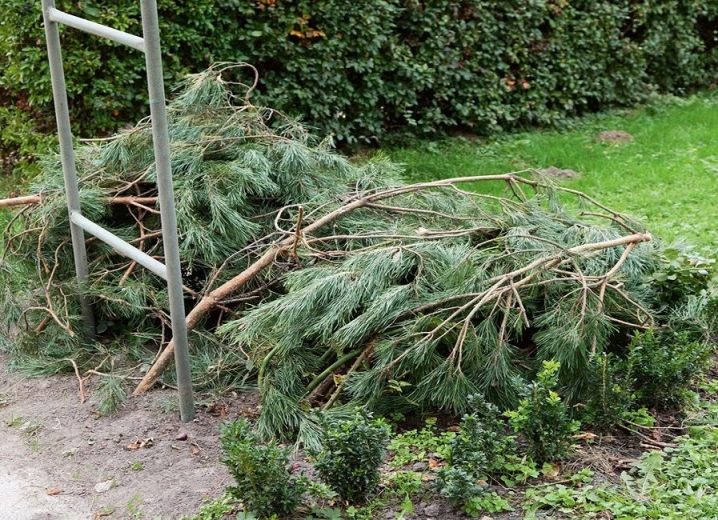
Transfer
If the plant looks bad or does not please gardeners for a long time with its flowering, it should be transplanted to a new place. This should be done in early spring. In this case, the plant will have time to take root in a new place.
The landing pit is prepared in advance. Its bottom is covered with a drainage layer. Pour soil mixed with complex fertilizer on top. After that, the bush is carefully dug up and placed in a hole prepared in advance.
Next, the soil around the trunk is tamped, and then generously watered with water.

Reproduction
Action can be propagated in several main ways.
- Cuttings. Cutting is one of the most convenient ways to propagate a shrub. Several shoots 15-20 centimeters long are cut from an adult plant. This is done in early summer. The bottom cut of each cutting is dipped in water with a root stimulator. The next day, the shoots are planted in loose soil at an angle. It is worth growing cuttings in a greenhouse. Twigs are transferred to open ground in the fall. They are transplanted to a permanent place of growth after another year and a half.
- By dividing the root. You can get new shrubs by dividing an adult plant into several parts. In the spring, the shrub is pruned, removing all old and weakened shoots. At the beginning of summer, the plant is carefully dug up. The rhizome is divided into several parts with a sharp knife or shovel. Further, the delenki are carefully instilled into separate holes.
- Seeds. For propagation of action, fresh planting material is used. He does not need preliminary preparation. Seeds are sown on well-loosened soil. They are not sprinkled with earth on top. Immediately after sowing, the area is watered with warm water. The first shoots usually appear on the site after 20-30 days.
- Layers. This is a quick and convenient way to propagate a bush. To begin with, a large hole is dug next to the plant. One of the shoots is carefully bent to the ground and covered with earth. To speed up the rooting process of the plant, the bark is slightly scratched at the site of the future root. The next spring, the seedling is separated from the mother bush and planted in a new place.
All these methods of plant propagation are quite effective.
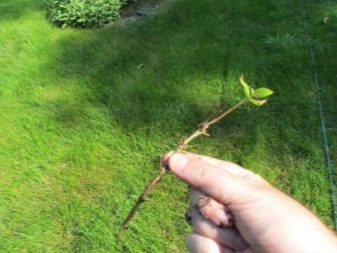

Diseases and pests
When growing a shrub on your site, it is important to protect it from insects and diseases. The following diseases are especially dangerous for a young plant.
- Powdery mildew. A dense white bloom appears on diseased plants in a short time. Over time, it thickens. The affected parts of the plants must be cut off with sharp scissors or pruning shears.After that, the area is treated with fungicides.
- Rust. The main symptom of this disease is the appearance of round rusty spots on the plant. In conditions of high humidity, this disease develops very quickly. Having noticed its signs, the gardener should treat the shrub with fungicides, following the instructions on the package. By the same principle, it is necessary to fight other fungal diseases.
Shrub owners rarely encounter pests. Conventional insecticides are used to control them. But if there are not very many pests on the site, they are simply collected by hand.
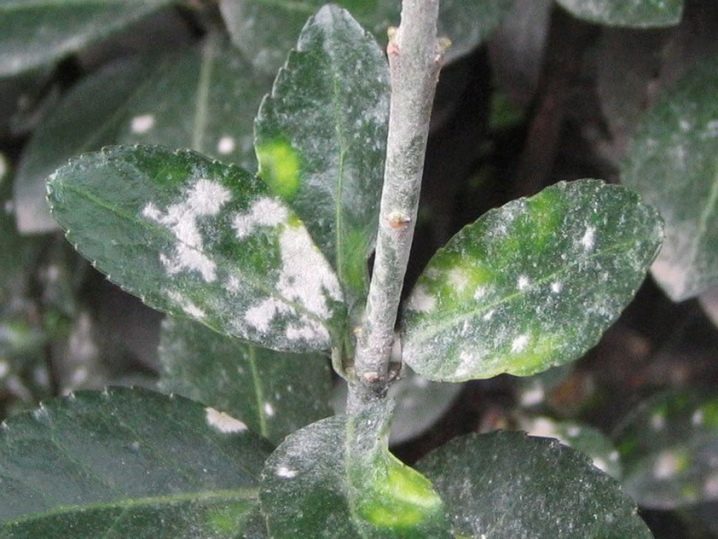
Application in landscape design
The spreading shrub will look beautiful both in the garden and next to the house. The action looks best against the background of conifers and other perennials. The plant goes well with lilacs and other flowering shrubs.
Such bushes also look beautiful next to buildings. Usually they are planted near gazebos or houses.
If you take proper care of the action, the bush will regularly delight the owners of the site with a lush and beautiful flowering.
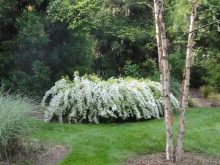

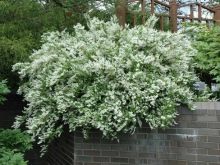

































































The comment was sent successfully.